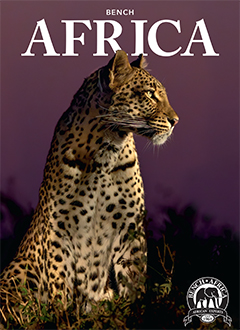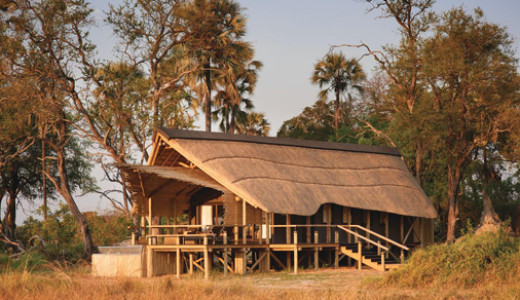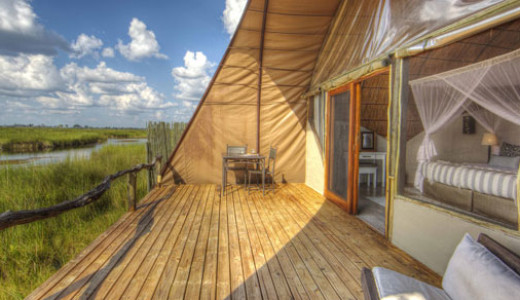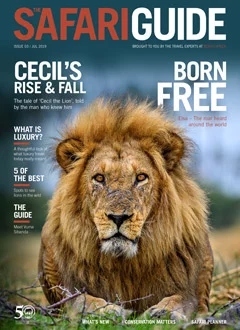The Okavango Delta in Northern Botswana is known as the “jewel” of the Kalahari - fed by the floodwaters from Angola. The largest inland delta on the planet, and an oasis in an otherwise dry environment, the Okavango Delta is known for its superb wildlife. Here you can find large populations of mammals and excellent birding, particularly in breeding season.
Northern Botswana is a renowned African safari destination, where tourist flock to because of is spectacular location (within close proximity to Zimbabwe, Zambia and Namibia) and its stunning reserve. The region is home to the Chobe National Park, Moremi Game Reserve and Central Kalahari Reserve.
There is certainly no bad time to visit the Delta and these other safari areas in northern Botswana, with each and every month of the year offering something new and unique and at the end of the day it's all going to boil down to what you want to experience, so let's take you through the year in northern Botswana - month by month and let you make up your mind on what best suits you...
Should I visit Northern Botswana in January?
This is when the bush is alive with activity.
January is the middle of the rainy season with spectacular afternoon thunderstorms. Daytime temperatures are warm, averaging 86°F (30°C). Night time averages are 68°F (20°C).
✅ For all you Twitchers this is a great time for bird watching. It is peak breeding time for many colourful migrant bird species
✅ Excellent wildflowers and brilliant green foliage abound
✅ Constant sounds day and night from insects and birds
✅ Attention shutterbugs! This is an ideal month for photography with brilliant colours and dramatic skies
✅ It is still low season so you can expect to pay lower rates and have fewer tourists
✅ Because of the baby animals predator numbers are high at this time of year
✅ It is low season so you can expect to pay lower rates and have fewer tourists
✅ A lot of wildlife remains in the heart of the delta, which has permanent water
❌ Game viewing is average
❌ Water levels can be too low for mokoro trips
❌ It can be hot with with afternoon rainstorms
❌ Some camps and lodges close their doors in January
❌ Parts of the Delta become inaccessible
Should I visit Northern Botswana in February?
The Okavango Delta is brilliant, noisy and alive.
Nights and days are still warm. There can be both wet and dry spells during this month.
✅ Ripe figs are eaten by many species including fruit bats, who make interesting night sounds while feeding
✅ Water lilies are at their flowering peak
✅ Colourful and noisy reed frogs are abundant
✅ All plants are growing actively due to the rain
✅ For all you Twitchers this is a great time for bird watching. In fact butterflies, birds, frogs and small creatures are at their most active
✅ The giant bullfrog emerges from months and sometimes years of hibernation to indulge in nocturnal feeding frenzies
✅ The resident game species do not have far to go for water and the young are almost as tall as the adults
✅ It is still low season so you can expect to pay lower rates and have fewer tourists
✅ A lot of wildlife remains in the heart of the delta, which has permanent water
❌ The rains continue in the form of afternoon thunderstorms with dramatic skies and sounds
❌Daytime temperatures can reach up to 104°F (40°C) but average around 86°F (30°C)
❌Parts of the Delta are inaccessible
❌ Water levels can be too low for mokoro trips
❌ Some camps and lodges are not open in February
Should I visit Northern Botswana in March?
Visit now and see the migration moving North through the Savute.
Temperatures are still warm both day and night but the air is drier and rains less frequent.
✅ Witness hundreds of zebra and wildebeest moving through the Savute marshlands
✅ Hear the calls of the last of the migratory birds before they move to the northern hemisphere
✅ In Moremi the Marula trees are fruiting which attracts bull elephants who wander from tree to tree in search of their favourite meals
✅ The start of the rutting leads to the sleek male impala cavorting to attract females
✅ It is still low season so you can expect to pay lower rates and have fewer tourists
✅ A lot of wildlife remains in the heart of the delta, which has permanent water
❌Parts of the Delta are inaccessible
❌ Water levels may still be too low for mokoro trips
❌ Some camps and lodges are not open in March
Should I visit Northern Botswana in April?
The first signs of the changing season appear.
Night time temperatures drop to below 68°F (20°C) on average but daytime temperatures continue to rise up to 104°F (40°C) on some days.
✅ Cooler morning temperatures with relatively high humidity leads to early morning mist – especially over the water
✅ The impala rut is in full swing and the impala noise continuesright through the night with major clashes between rival males
✅ Baboons are often seen with impala as they assist with the safety of the preoccupied antelope
✅ The trees have completed flowering and fruit is ripening overwith massive sausages hanging from the Sausage Trees
✅ The reptiles are actively breeding and feeding in anticipation of the dry spell ahead
✅ It is now the shoulder season so you can expect to pay relatively lower rates and still have fewer tourists that you would experience in peak season
✅ Water levels are highest – good for mokoro trips
❌ The days can still be very hot.
Should I visit Northern Botswana in May?
Flood waters from Angola start to reach the top of Okavango Delta and begin their slow, deliberate progress through the Delta.
The rains are over and the nights are cooler with temperatures averaging 59°F (15°C). Daytime temperatures remain warm but have lost their edge with maximum temperatures seldom exceeding 95°F (35°C).
✅ The buffalo begin to group into large herds and visit the permanent waterholes more often as the seasonal pans begin to dry
✅ Breeding herds of elephant increases in density daily as they visit the permanent waters
✅ The predators begin to thrive again as their colouring blends in with their surroundings
✅ Migratory birds begin their arduous flights to winter feeding and breeding grounds
✅ Water levels are highest – good for mokoro trips
✅ It is still shoulder season so you can expect to pay relatively lower rates and still have fewer tourists that you would experience in peak season
❌ Jackets are advisable for night drives.
❌ Green colours start to fade into the duller dry season colours
Should I visit Northern Botswana in June?
Winter – an exciting time in Botswana.
Temperatures have dropped to their coldest by the end of the month.
✅ The African wild dogs begin to search for their dens. Once they have denned these endangered animals are easy to view for 3 – 4 months
✅ Animals and their predators now concentrated at the permanent waterholes
✅ Pans are drying up across the region
✅ Excellent wildlife viewing in general
✅ Daytime temperatures rise up to a comfortable 77°F (25°C) and dusty dry conditions begin to dominate the region.
✅ Water levels are highest – good for mokoro trips
✅ It is still shoulder season so you can expect to pay relatively lower rates and still have fewer tourists that you would experience in peak season
❌ It is very cold on early morning and night drives due to wind chill
❌ Night time temperatures reaching as low as 41°F (5°C)
Should I visit Northern Botswana in July?
An abundance of animals congregate near the water and floodplains making it a special time of the year.
The nights are still cold but the days are marginally warmer and the weather becomes typical of Botswana – sunny and clear.
✅ The floods arrive in the Okavango Delta and other areas aftera slow path from the wet Angolan highlands thousands of kilometres away
✅ Water makes its way into areas that were dry the day before
✅ Mokoro and boat trips become even more exciting as new places can now be accessed
✅ Attention shutterbugs! Soft early morning and evening light combines with dust to provide excellent photo opportunities
✅ This a good time for seeing African wild dogs
❌ Lodges tend to charge their highest rates as we are now entering peak season.
Should I visit Northern Botswana in August?
There is plenty of action around – with patience and perseverance, the rewards are great.
The weather is warming, even at night, with daytime peaks averaging near 86°F (30°C) and night time averages rising to 50°F (10°C).
✅ Animal herds are getting larger
✅ Limited space near the water leads to tension between breeding herds of elephant which results in somefascinating game viewing
✅ The nights are filled with elephant sounds
✅ Birds such as herons and storks start to concentrate at the Godikwe heronry and begin nest-building
✅ The floods have passed through the Delta and reach as far south as Maun
✅ A good time for mokoro rides
✅ This a good time for seeing African wild dogs
❌ The bush is bare and dust pervades throughout the region
❌ We are still in peak season so you can expect to pay peak rates
Should I visit Northern Botswana in September?
The climate has changed again and winter is all but gone.
Night time temperatures rise rapidly within the month and by month’s end, with averages reaching 59°F (15°C) and daytime temperatures soaring well into the 80’s (high 20’s).
✅ The sun shines, the skies are clear and it is extremely dry
✅ The elephant and buffalo concentrations are still great
✅ The predators are busy as the season takes its toll on prey species – a time of plenty for the lions
✅ Carmine bee-eaters and other migrant birds return from winter grounds
✅ Fish begin to get active again
✅ A good time for mokoro rides
❌ Water levels slowly start to drop as the waters from Angola subside
❌ September can start to get quite hot.
Should I visit Northern Botswana in October?
Temperatures soar and game viewing is exceptional.
Day time temperatures rise regularly above 104°F (40°C) and nights are warm with averages in the high 60’s (high teens Celcius).
✅ The pervading dust makes all scenes dramatic
✅ Predator chases erupt into clouds of dust as the eternal game of “eat or be eaten” plays out daily on the wide open plains
✅ There are fishing frenzies with the annual catfish run in the rivers
✅ The Godikwe heronry is full of activity with thousands of birds breeding and nesting
✅ A good time for mokoro rides
✅ This is generally seen as shoulder season so you can expect to pay mid rates
❌ Morning game viewing activities begin very early and nightdrives depart later to avoid the heat of the day
Should I visit Northern Botswana in November?
A wonderful time for photographers as there is excellent colour, action and visibility.
Temperatures remain high both day and night.
✅ Game viewing continues to improve until the day of the first rains, normally around mid November
✅ The animals all seek an end to the dryness and dust. Once the rain comes, they disperse to feed on the new vegetation and drink from the seasonal pans
✅ The antelope birthing season begins with tsessebe, followed by impala and lechwe
✅ Predators seek out the vulnerable young and kill many times a day to get their fill – which means plenty of action
✅ Trees burst into life and short green grass begins to appear
✅ Excellent visibility for game viewing
✅ There are plenty of baby animals, which attract predators
✅ Excellent bird watching time as migrants are present
✅ This is generally seen as shoulder season so you can expect to pay mid rates
❌ Temperatures can be hot at this time of year
Should I visit Northern Botswana in December?
The pans remain full and the colours shine in brilliant green.
The rains become more regular with thunderstorms every few days.
✅ The impala complete their lambing
✅ The wildebeest finish calving within a few weeks
✅ Protein-rich grasses feed mother antelopes while the lambs and calves grow at astounding speed
✅ While grazers enjoy the green, tender mouthfuls, the predators are vigilant. With their winter camouflage making them stand out, they have to work harder for their catch
✅ All the migrant birds have returned
❌ The bush becomes denser providing more hiding places from which predators can stalk their prey. This can also mean that game is more difficult to spot




































